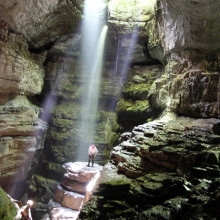Our question this week concerns caves - we find out if more carbon dioxide in the atmosphere causes caves to grow quicker. Could an acidic atmosphere create cathedral-sized caverns?
In this episode

00:00 - Speed of Caves?
Speed of Caves?
Jan Zalasiewicz, University of Leicester:Carbon dioxide in the atmosphere dissolves in rainwater and produces weak acid - carbonic acid. This weak acid reacts with rocks and other materials and can basically dissolve them. So it will take limestone, it will even take some of the unstable minerals in granite and basalt and such like and will dissolve them, neutralising itself in the process. So one of the things that it will do is if you have more carbon dioxide in the atmosphere as we have now, then the level of acid in the rain therefore becomes higher and therefore amounts and rates of this dissolution process will become greater and in fact are currently becoming greater.
Dave Mattey, Professor of Isotope Geology, Earth Science at Royal Holloway: In answer to the question the caves are certainly formed by solution of limestone by carbonic acid, but it's not really the level of CO2 in the atmosphere that does the damage that causes the water to be acidic enough to form caves. The atmosphere at the present time contains about 390ppm of carbon dioxide which is about 0.03%, which will dissolve in rain to form a very weak solution of carbonic acid. This will only slowly dissolve limestone but not at a sufficiently fast rate to form very large cavities or caves. What forms very large caves is the fact that they are covered by a layer of soil and it's the formation of carbon dioxide in the soil which can grow to quite large concentrations, sometimes up to maybe 1% or up to 4 or 5 percent sometimes in the more humid parts of the world. When rainfall falls through this very carbon dioxide rich soil zone it forms a very strong solution of carbonic acid. It's this very strong carbonic acid that can form cave cavities in limestone much more quickly over a period of tens to hundreds of thousands of years. So any change in the carbon dioxide level of the atmosphere: we're currently at 390ppm and the models predict it might go up to perhaps 420, perhaps even 450ppm in the next 50 years or so. This change doesn't have any impact really on the formation of caves. One other thing is that one of the outcomes of rising atmospheric CO2 levels is that it may affect the productivity of plants. There maybe an indirect link between rising CO2 levels and the formation of caves. If the plant and forest canopy become more vigorous then the soil might be expected to produce more CO2 so the caves might conceivably begin to grow a bit faster.










Comments
Add a comment